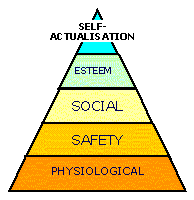 |
|||||||||||||||||||||||
|
What motivates people? |
Societies in transition employ methods and agents of change. In participatory planning processes (Planning for Real) and self-organised meetings (Open Space Technology) we saw examples of methods of change that involve people in a very direct way in laying down the foundations for transition. As permaculturists, the more we understand the value of meaningful participation and how to achieve it, the more we will be able to offer ourselves as those agents of change. WHAT MOTIVATES PEOPLE? What makes people get involved in things outside of their immediate life? In seeking to involve people in transforming our society, we have first to understand what motivates them to want to participate. If people are preoccupied in meeting basic needs, it may be unlikely that they will have the time or inclination to get involved in something that while it may offer promise for tomorrow, is not offering anything necessarily today. So what are the normal human behavioural traits? Do they necessarily exist or is there some guide that at least provides us with a framework against which we can test experience, and then maybe go on to discover more. Abraham Maslow, an American psychologist, moved on from studying the psychology of those presenting as unwell to seeking out and studying people acceptably described as healthy and successful. He decided from his studies that almost everyone wants to be happy and loving, but that they have particular needs that they must meet before they can act unselfishly. Most people want more than they have, such that when they have met their most basic needs, they then develop higher needs. Maslow created a hierarchy of needs going up through five levels (below and see figure) with the four being survival needs that provide a basic motivation for life. These needs are not rigid and will vary from person to person. As a need is satisfied, an unsatisfaction is developed at the next level of need, which then provides motivation for action. Movement through the levels may not be a certainty for everyone, but we could describe it as an overall tendency. The example of a newborn baby is helpful since it is not hard to see an expected progression up the first three levels occurring in the first few weeks of life.
PHYSIOLOGICAL NEEDS - biological necessities such as food, water, oxygen and the need for sleep. These needs are the strongest because illness and death occur if not met SAFETY NEEDS – shelter, security, protection. Children more commonly have this need. Adults feel unsafe during emergencies or times of disorder like rioting SOCIAL NEEDS – the need to escape loneliness and alienation, to give and receive love, and a sense of acceptance and belonging ESTEEM NEEDS - the need to feel valuable; to have self-respect and the respect of others (a healthy level of ego). Unmet and people may feel inferior, weak, helpless, and worthless SELF-ACTUALISATION NEEDS – unleashed from worrying about lower-order needs, a person can grow creatively and can strive to fulfil their potential (find their true calling) Self-fulfillers often usefully arrive at different perceptions of means and ends. They are healthy psychologically, have a developed sense of humour, may be centred in solving problems, in perceiving everyday life realistically, and be markedly free of stereotypes. They are accepting of pragmatism and impressively fresh in their ability for philosophical thought. We should not confuse self-actualisation with fame or fortune. While wealthy or celebrated people might reach self-actualisation, we probably know many who have attained the highest level of happiness and who are rarely in the public eye, being known only by family and friends. We should also recognise that the hierarchy is dynamic and that our needs at any one time are always shifting. Even self-actualisers have to eat and sleep sometime. It is perfectly possible to operate in life somewhere around the middle of the hierarchy i.e. at the level of satisfying social and affiliation needs through stable loving relationships and a circle of friends. But there may be a deep yearning to accomplish things that would move us on and up through the next level, that of needs for esteem. Given space, some of us will evolve into sensing our own needs and doing something about it. In a workplace or community setting, it may be important for persons at this level to be helped by others to recognise some of their achievements and thus meet the need for esteem. A poor manager may simply guess at what motivates an individual at any time, whereas someone who looks at Maslow's theory will try to understand what motivational step a person is likely to fit into; will know that advancement is through one step (or level) at a time; and that no level is to be skipped on the way to higher levels. Societies develop when people reach a particular level in Maslow's hierarchy - once people meet their physiological needs and they feel safe, they begin to develop a culture and an advanced civilisation. WHO SHOULD BE INVOLVED? A stakeholder is the contemporary description for those expected to be involved in achieving change. The definition is that a stakeholder is anyone who is affected by, or can influence, the decisions or actions for change. It’s not that straightforward as it is possible to identify at least four different categories of stakeholder:
The reality may be even more complex, but the distinction between each stakeholder is important. You may need to use different processes to involve each one. It is also important to recognise that in pursuing change, we are also often pursuing understanding. Thus there may be others we wish to involve because they have information that we need or can support us. How do you decide the different forms of involvement that are appropriate for each of these? It really depends on your understanding of the dynamic that they bring as a stakeholder. It is worthwhile carrying out a stakeholder analysis against the backdrop of the issue or goal. Start by listing all the stakeholders you can think of and then assess each of them on the following basis (map out a chart with columns):
You might find that your analysis shows that you need more information about particular stakeholders (i.e. their potential for influence, uncertainty on their likely viewpoint). Having done as much research as you can, you then work out your strategies for approaching and involving the various stakeholders. In general, high influence indicates a need to involve them in some way. Can you choose not to involve them if you know they have strong opposition? Ultimately your best hope is for these stakeholders (as for all the rest) to be exposed to a range of opinion. Since our aim is for the process itself to flourish, you may decide to find some way to balance or neutralise any excessive influence or opposition. Where the stakeholder is a group rather than an individual, your desire for the direct participation of everyone may have to be balanced by the reality of achieving it. The option is representation where one person or a small group speaks on behalf of a larger number. Representation is sometimes used as a cheap and controllable alternative to direct participation, and so be aware of this and follow these safeguards:
Don’t let them act as representatives, but encourage them to speak for themselves, as individuals, while they act on behalf of all stakeholders. This will avoid polarisation and the deadlock that sometimes comes if they think that they have to always go back and consult their group. HOW SHOULD THEY BE INVOLVED? Participation is about autonomy and power. People are usually more committed to their own decisions than to the decisions of others, and need the promise that their decisions will have attention and will be carried out. Sherry Arnstein (1969) was interested in citizen involvement in planning processes. She made the link between participation and power, and recognised that it is the redistribution of power that enables have-not citizens, presently excluded from political and economic processes, to be deliberately included in the future. Her model is the Ladder of Participation. Power is redistributed as participants climb up each rung of the ladder. This is the way the have-nots can join in determining how information is shared, goals and policies are set, resources are allocated, and programs are operated. Thus there is a critical difference between going through the empty ritual of participation and having the real power needed to affect the outcome of the process.
Understanding participation involves understanding power - the ability of the different interests to achieve what they want. Power will depend on who has information and money. It will also depend on people's confidence and skills. Many organisations are unwilling to allow people to participate because they fear loss of control: they believe there is only so much power to go around, and giving some to others means losing your own. Educate them! Mark Fisher - Permaculture Design course handout notes www.self-willed-land.org.uk mark.fisher@self-willed-land.org.uk |
||||||||||||||||||||||

